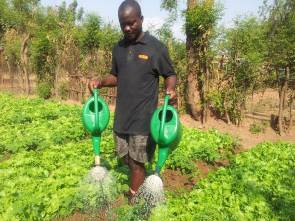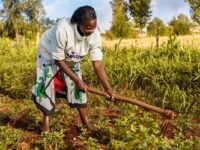A lecturer at the Kwame Nkrumah University of Science and Technology says contrary to what anyone believes,  Ghana is food insecure.
Ghana is food insecure.
Prof. Simon Cudjoe Fialor says it doesn’t take rocket science to know that we are still far away from food security.
Heavy dependence on foreign aid for Agriculture
“As long as we are importing food and with money that we didn’t generate, we are food insecure”, he told rawgist.com’s Bernard Buachi in an interview. He explains that our entire agricultural sector is heavily dependent on foreign aid including government’s flagship agricultural programme; Planting for Food and Jobs.
Such an economic state, he says should not be misconstrued that we are food secure.
Concepts of food security
This extract from http://www.fao.org explains the flexibility and evolving concept of food security with time:
The continuing evolution of food security as an operational concept in public policy has reflected the wider recognition of the complexities of the technical and policy issues involved. The most recent careful redefinition of food security is that negotiated in the process of international consultation leading to the World Food Summit (WFS) in November 1996. The contrasting definitions of food security adopted in 1974 and 1996, along with those in official FAO and World Bank documents of the mid-1980s, are set out below with each substantive change in definition underlined. A comparison of these definitions highlights the considerable reconstruction of official thinking on food security that has occurred over 25 years. These statements also provide signposts to the policy analyses, which have re-shaped our understanding of food security as a problem of international and national responsibility.
Food security as a concept originated only in the mid-1970s, in the discussions of international food problems at a time of global food crisis. The initial focus of attention was primarily on food supply problems – of assuring the availability and to some degree the price stability of basic foodstuffs at the international and national level. That supply-side, international and institutional set of concerns reflected the changing organization of the global food economy that had precipitated the crisis. A process of international negotiation followed, leading to the World Food Conference of 1974, and a new set of institutional arrangements covering information, resources for promoting food security and forums for dialogue on policy issues.
The issues of famine, hunger and food crisis were also being extensively examined, following the events of the mid 1970s. The outcome was a redefinition of food security, which recognized that the behaviour of potentially vulnerable and affected people was a critical aspect.
A third, perhaps crucially important, factor in modifying views of food security was the evidence that the technical successes of the Green Revolution did not automatically and rapidly lead to dramatic reductions in poverty and levels of malnutrition. These problems were recognized as the result of lack of effective demand.
Official concepts of food security
The initial focus, reflecting the global concerns of 1974, was on the volume and stability of food supplies. Food security was defined in the 1974 World Food Summit as:
“availability at all times of adequate world food supplies of basic foodstuffs to sustain a steady expansion of food consumption and to offset fluctuations in production and prices”.
In 1983, FAO expanded its concept to include securing access by vulnerable people to available supplies, implying that attention should be balanced between the demand and supply side of the food security equation:
“ensuring that all people at all times have both physical and economic access to the basic food that they need”.
In 1986, the highly influential World Bank report “Poverty and Hunger” focused on the temporal dynamics of food insecurity. It introduced the widely accepted distinction between chronic food insecurity, associated with problems of continuing or structural poverty and low incomes, and transitory food insecurity, which involved periods of intensified pressure caused by natural disasters, economic collapse or conflict. This concept of food security is further elaborated in terms of:
“access of all people at all times to enough food for an active, healthy life”.
By the mid-1990s food security was recognized as a significant concern, spanning a spectrum from the individual to the global level. However, access now involved sufficient food, indicating continuing concern with protein-energy malnutrition. But the definition was broadened to incorporate food safety and also nutritional balance, reflecting concerns about food composition and minor nutrient requirements for an active and healthy life. Food preferences, socially or culturally determined, now became a consideration. The potentially high degree of context specificity implies that the concept had both lost its simplicity and was not itself a goal, but an intermediating set of actions that contribute to an active and healthy life.
The 1994 UNDP Human Development Report promoted the construct of human security, including a number of component aspects, of which food security was only one. This concept is closely related to the human rights perspective on development that has, in turn, influenced discussions about food security. (The WIDER investigation into the role of public action into combating hunger and deprivation, found no separate place for food security as an organizing framework for action. Instead, it focused on a wider construct of social security which has many distinct components including, of course, health and nutrition).
The 1996 World Food Summit adopted a still more complex definition:
“Food security, at the individual, household, national, regional and global levels [is achieved] when all people, at all times, have physical and economic access to sufficient, safe and nutritious food to meet their dietary needs and food preferences for an active and healthy life”.
This definition is again refined in The State of Food Insecurity 2001:
“Food security [is] a situation that exists when all people, at all times, have physical, social and economic access to sufficient, safe and nutritious food that meets their dietary needs and food preferences for an active and healthy life”.
This new emphasis on consumption, the demand side and the issues of access by vulnerable people to food, is most closely identified with the seminal study by Amartya Sen. Eschewing the use of the concept of food security, he focuses on the entitlements of individuals and households.
The international community has accepted these increasingly broad statements of common goals and implied responsibilities. But its practical response has been to focus on narrower, simpler objectives around which to organize international and national public action. The declared primary objective in international development policy discourse is increasingly the reduction and elimination of poverty. The 1996 WFS exemplified this direction of policy by making the primary objective of international action on food security halving of the number of hungry or undernourished people by 2015.
Essentially, food security can be described as a phenomenon relating to individuals. It is the nutritional status of the individual household member that is the ultimate focus, and the risk of that adequate status not being achieved or becoming undermined. The latter risk describes the vulnerability of individuals in this context. As the definitions reviewed above imply, vulnerability may occur both as a chronic and transitory phenomenon. Useful working definitions are described below.
Food security exists when all people, at all times, have physical, social and economic access to sufficient, safe and nutritious food which meets their dietary needs and food preferences for an active and healthy life. Household food security is the application of this concept to the family level, with individuals within households as the focus of concern.
Food insecurity exists when people do not have adequate physical, social or economic access to food as defined above.





